ADHD
"Closing the Loop" With Our Kids and Teens With ADHD
Teaching our children executive functioning.
Posted August 13, 2024 Reviewed by Abigail Fagan

How many times have you walked into a room and noticed that your child, teen, young adult, or partner with ADHD has left a trail of things around the kitchen where the sandwich was made, the ice cream was scooped, or the coffee was made? The drawers and cabinet doors are open and none of the things or drawers or cabinets have been returned to their original placement.
If I had to guess, my guess is, often. ADHD is a disorder of attention, physical and mental hyperactivity as well as impulsivity. The person with ADHD has many ideas, and feels the need to act on most of them, even if they’re not well timed.
How many times have you watched your teen, in the middle of a homework assignment, stop and move forward on an idea that is not related to the homework assignment or anything else to their daily routine? For example, your teen leaves his assignment because he needs to check if his package was delivered or needs to find a t-shirt that he hasn’t seen in a while. Once again, my guess is, often.
ADHD is also a disorder of executive dysfunction. That does not mean that a person with ADHD is lazy or forgetful.
What does that translate into on a daily basis?
- Difficulty starting a task that is perceived as taking too long (e.g., homework, cleaning her room, etc)
- Working through a task until it’s done
- Difficulty planning ahead
- Difficulty with estimating how long something is going to take
- Difficulty prioritizing what needs to get done based on deadlines
- Stopping one task, when it’s not yet completed, to start another one
- Forgetting to return to the original, unfinished task
- Forgetting belongings and items needed for school or sports
Closing the loop refers to the idea of starting a task and finishing it, not only finishing it but returning everything back to its place so that a room or space doesn’t look like your house was burglarized!
For example, if your child takes a shower, as a parent, we can coach our children, teens, and young adults to think about items for a task, the steps needed to complete the task, and then the steps needed to “clean up” and return the space to what it looked like before.
In essence, closing the loop refers to finishing what was started and returning all things back to their original space. Let’s break down the take a shower loop.
For many parents, the bathroom looks like a steam bath, the shower curtain or door is open, dirty clothes are on the floor, the bath mat looks like it’s been beaten, and a towel is on the floor.
This is what you’re asking your child, teen, or young adult to do instead:
- Taking dirty laundry and placing it in a hamper or other designated space
- Placing the wet towel on a hook, in the washer or other designated space
- Taking any shower items that were brought into the shower
- Turning off the light and fan
- Returning any items back to their place in the bathroom
This is a big list to commit to memory so a physical list that is posted on the wall (until your child, teen, or young adult can internalize the list) may be needed.
Implementation includes introducing the idea to your child, teen, or young adult and then consistently holding him or her to this expectation. That is, each time you walk into the bathroom and see that things are out of place, ask your child to close the loop in the bathroom. A physical list will take care of the “What do you want me to do?” question.
You can repeat this with any task and in any room of your house. This also includes cleaning their space. Break down the “clean your room” task into smaller tasks that can include:
- Pick up laundry and place it in the hamper
- Create a pile of dishes, silverware, and cups and bring it down to the dishwasher
- Empty garbage can
- Change sheets
- Put away clean laundry
- Wipe down furniture
- Vacuum floor
Many of our children, teens, and young adults with ADHD struggle to start a task and complete it. They struggle to “close the loop” by returning the space to its original state which is a needed skill for all phases of their life, and especially as life’s demands become more complex with age.


